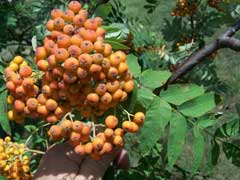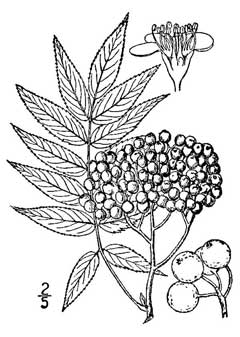 |
|
http://commons.wikimedia.org/wiki/User:Bruce_Marlin |
 |
| USDA-NRCS PLANTS Database / Britton, N.L., and A. Brown. 1913. An illustrated flora of the northern United States, Canada and the British Possessions. 3 vols. Charles Scribner's Sons, New York. Vol. 2 |
Translate this page:
Summary
Bloom Color: White. Main Bloom Time: Early spring, Late spring, Mid spring. Form: Oval.
Physical Characteristics

 Sorbus americana is a deciduous Tree growing to 10 m (32ft) by 7 m (23ft) at a slow rate.
Sorbus americana is a deciduous Tree growing to 10 m (32ft) by 7 m (23ft) at a slow rate.
See above for USDA hardiness. It is hardy to UK zone 2. It is in flower from May to June, and the seeds ripen from September to October. The species is hermaphrodite (has both male and female organs) and is pollinated by Insects.
Suitable for: light (sandy), medium (loamy) and heavy (clay) soils, prefers well-drained soil and can grow in nutritionally poor soil. Suitable pH: mildly acid, neutral and basic (mildly alkaline) soils. It can grow in semi-shade (light woodland) or no shade. It prefers moist soil. The plant can tolerates strong winds but not maritime exposure.
UK Hardiness Map
US Hardiness Map
Synonyms
S. microcarpa.
Plant Habitats
Woodland Garden Canopy; Secondary; Sunny Edge;
Edible Uses
Edible Parts: Fruit
Edible Uses:
Fruit - raw or cooked[62, 101]. Rich in iron and vitamin C[213, 226]. The fruit is used mainly in making pies, preserves etc, but it can also be eaten raw after a frost because it turns sweeter then[101, 183]. The fruit has a high tannin content and so should only be used in moderation if eaten raw[226]. It can also be dried and ground into a meal[226]. The fruit is produced in dense clusters and is up to 8mm in diameter[200].
References More on Edible Uses
Medicinal Uses
Plants For A Future can not take any responsibility for any adverse effects from the use of plants. Always seek advice from a professional before using a plant medicinally.
Antiscorbutic Antiseptic Appetizer Astringent Blood purifier Digestive Diuretic Laxative
Miscellany Vitamin C
The inner bark has astringent and antiseptic properties[213]. It is also used as a blood purifier and appetite stimulant[257]. An infusion is used (sometimes with the terminal buds added) in the treatment of colds, debility, diarrhoea etc[222, 257]. When mixed with sweet flag (Acorus calamus) it is used as a tonic[257]. A poultice of the burnt bark has been used in the treatment of boils[257]. The fruit is antiscorbutic, diuretic, mildly laxative, astringent and digestive[226, 257]. It is an ideal accompaniment for foods that are hard to digest[226]. A tea from the berries is antiscorbutic and astringent[213, 222]. It has been used as a rectal wash for piles[213]. It is also used in homeopathic remedies[46, 82].
References More on Medicinal Uses
The Bookshop: Edible Plant Books
Our Latest books on Perennial Plants For Food Forests and Permaculture Gardens in paperback or digital formats.

Edible Tropical Plants
Food Forest Plants for Hotter Conditions: 250+ Plants For Tropical Food Forests & Permaculture Gardens.
More

Edible Temperate Plants
Plants for Your Food Forest: 500 Plants for Temperate Food Forests & Permaculture Gardens.
More

More Books
PFAF have eight books available in paperback and digital formats. Browse the shop for more information.
Shop Now
Other Uses
Miscellany Wood
Wood - soft, light, close grained, with little strength[82, 229, 235]. It weighs about 34lb per cubic foot[235] and is of no commercial value[229].
Special Uses
Food Forest
References More on Other Uses
Cultivation details
Landscape Uses:Specimen. Succeeds in most reasonably good soils in an open sunny position[11]. Tolerates partial shade[188], though it fruits better in a sunny position[K]. Dislikes dry soils[188]. Able to succeed in poor soils and to become established on exposed open ground[229]. A slow-growing and relatively short-lived tree in the wild[229], it fruits freely in Britain[11]. Plants are susceptible to fireblight[188]. Special Features:Attracts birds, North American native, Attractive flowers or blooms. The plant is heat tolerant in zones 8 through 1. (Plant Hardiness Zones show how well plants withstand cold winter temperatures.
Plant Heat Zones show when plants would start suffering from the heat.
The Plant Heat Zone map is based on the number of "heat days" experienced in a given area where the temperature climbs to over 86 degrees F (30°C).
At this temperature, many plants begin to suffer physiological damage. Heat Zones range from 1 (no heat days) to 12 (210 or more heat days).
For example Heat Zone. 11-1 indicates that the plant is heat tolerant in zones 11 through 1.) For polyculture design as well as the above-ground architecture (form - tree, shrub etc. and size shown above) information on the habit and root pattern is also useful and given here if available. The plant growth habit is a standard with a non-suckering single trunk [1-2]. In garden design, as well as the above-ground architecture of a plant, root structure considerations help in choosing plants that work together for their optimal soil requirements including nutrients and water. The root pattern is branching: a heart root, dividing from the crown into several primary roots going down and out [2-1].
References Carbon Farming Information and Carbon Sequestration Information
Temperature Converter
Type a value in the Celsius field to convert the value to Fahrenheit:
Fahrenheit:
The PFAF Bookshop
Plants For A Future have a number of books available in paperback and digital form. Book titles include Edible Plants, Edible Perennials, Edible Trees,Edible Shrubs, Woodland Gardening, and Temperate Food Forest Plants. Our new book is Food Forest Plants For Hotter Conditions (Tropical and Sub-Tropical).
Shop Now
Plant Propagation
Seed - best sown as soon as it is ripe in a cold frame[78, 80]. If you have sufficient seed it can be sown in an outdoor seedbed[78, 80]. Stored seed germinates better if given 2 weeks warm then 14 - 16 weeks cold stratification[98], so sow it as early in the year as possible. Prick out the seedlings into individual pots when they are large enough to handle. Seedlings are very slow to put on top-growth for their first year or two[11], but they are busy building up a good root system. It is best to keep them in pots in a cold frame for their first winter and then plant them out into their permanent positions in late spring.
Other Names
If available other names are mentioned here
Native Range
NORTHERN AMERICA: Canada, Québec, Nova Scotia, Ontario, Prince Edward Island, New Brunswick, Newfoundland and Labrador, United States, Connecticut, Indiana, Maine, Massachusetts, Michigan, New Hampshire, New York, Pennsylvania, Vermont, West Virginia, Illinois (n. (Ogle Co.)), Minnesota, Wisconsin, Georgia (north), Maryland (west), North Carolina (west), Tennessee (northeast), Virginia (west),
Weed Potential
Right plant wrong place. We are currently updating this section.
Please note that a plant may be invasive in one area but may not in your area so it's worth checking.
Conservation Status
IUCN Red List of Threatened Plants Status :

Growth: S = slow M = medium F = fast. Soil: L = light (sandy) M = medium H = heavy (clay). pH: A = acid N = neutral B = basic (alkaline). Shade: F = full shade S = semi-shade N = no shade. Moisture: D = dry M = Moist We = wet Wa = water.
Now available:
Food Forest Plants for Mediterranean Conditions
350+ Perennial Plants For Mediterranean and Drier Food Forests and Permaculture Gardens.
[Paperback and eBook]
This is the third in Plants For A Future's series of plant guides for food forests tailored to
specific climate zones. Following volumes on temperate and tropical ecosystems, this book focuses
on species suited to Mediterranean conditions—regions with hot, dry summers and cool, wet winters,
often facing the added challenge of climate change.
Read More
Expert comment
Author
Marshall.
Botanical References
1143200
Links / References
For a list of references used on this page please go here
Readers comment
© 2010, Plants For A Future. Plants For A Future is a charitable company limited by guarantee, registered in England and Wales. Charity No. 1057719, Company No. 3204567.